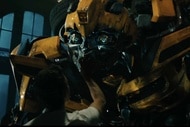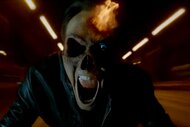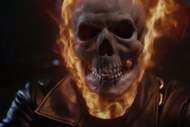Create a free profile to get unlimited access to exclusive videos, sweepstakes, and more!
Comics show the story of New York's transit system in Underground Heroes exhibition

It's a bird! It's a plane! No, it's the New York City subway! When you think about New York City's transit system, you may think of the long delays before you think of comics. But the truth is, through the decades, everything from comic books to newspaper comic strips has featured the city's transit, which enables us to trace the many challenges and changes the system has faced over the years. It's this evolution and the role transit has played in comics over the years that you can see and explore in the New York Transit Museum's Underground Heroes: New York City Transit in Comics exhibit.
The exhibit offers a closer look at how subways, buses, and other New York transit systems have starred in everything from editorial cartoons to comic strips and even set the scenes for heroes and villains alike throughout Marvel and DC comics. The entire show came to be thanks to a single person's daily commute, the exhibit's associate curator Jodi Shapiro.
"On one of my rides to work, I started thinking about how different artists would interpret the routine. Painters and photographers have certainly made a lot of work dealing with transportation in New York, as well as scores of writers and [I] started to wonder: Has New York's transit system been featured in comics on the same scale? I wasn't entirely sure!" Shapiro told SYFY WIRE in an email interview.
Her research into the area showed that not only did the transit system appear in comics, but the two developed together.
"You could say that New York's transit system and comic books grew up together. Mass media such as newspapers were gaining popularity just as the elevated lines were being built in the city in the mid-1800s," Shapiro says. "Since the New York Transit Museum's mission is to tell the story about our vast transportation system, a show about how the comics told aspects of the story seemed a natural fit."
The exhibit features comics of all sorts, but it doesn't start right away in the world of superheroes. Instead, it first dives into the world of local humor publications Puck and Judge, in which artists would highlight issues with transportation through their comics. Here you'll find items such as a piece from 1881 about horse-drawn vehicles and a 1909 comic strip about a crowded subway.
From there the exhibit is broken into sections with titles such as "Newspapers, Marauding Monsters and Terrifying Tales," in which visitors learn how real-world fears were being connected with the subway. For example: In "Monsters on the Prowl: In the Shadow of Tragg... He Who Walks the Earth!" a creature uses the subway as his underground lair. And in 1983, the X-Men discovered the Morlocks living beneath the city.
The research process to find and decide what to include in the exhibit took about two years, according to Shapiro, who loved the process. One thing she wanted to be crystal clear in the exhibit was that "comics are a multipurpose art form with real depth."
"The New York Transit Museum tells many different aspects of the story of New York through the lens of transportation, and this exhibit aims to do the same. Using comics, we are able to talk about a lot of different things relating not only to New York's transit system but also the social fabric of New York City," she explains.
As they crafted the exhibit, Shapiro says they wanted to "include as many different styles of art and storytelling as possible" and that diversity was important when it came to characters and creators.
"The most important thing was to have good and compelling work that would draw people to visit the exhibit, so there's a whole range of material from the straight-ahead superhero stories, to some very abstract conceptual work," she says. "There are some pieces that have a lot of text, and some that are wordless. Some work is very traditional, and some is highly experimental."
The exhibit contains a nice variety of comics genres, but it is especially fun to find the superheroes. Throughout, you'll find fight scenes involving heroes and transit in almost every section. You'll spot Ms. Marvel facing Sabretooth in 1992's "Sabretooth Stalks the Subway!" and Spider-Man catching the Metro-North Railroad to hunt down a criminal in 1985's "The Commuter Cometh!"
Other familiar comic characters you'll find are The Punisher, Daredevil, Gwenpool, Superman, Lois Lane, and Squirrel Girl along with recognizable industry names such as Wil Eisner, Erica Henderson, Jack Kirby, Kelly Sue DeConnick, and Greg Rucka.
Not everything is comic books, though, as there's a decent balance throughout and plenty of strips and pieces from other media like MAD Magazine.
There are over 120 artists represented in the show, but the exhibit still feels small and intimate; it allows you to get close to each comic to take a look inside at the scenes where transit comes into play.
"The Transit Museum's archives [are] vast and our job is to make it publicly accessible, so we wanted to include work from our collection, including materials from Amelia Opdyke Jones. She had a long career in comics and in illustration, but the most recognizable work she created as a staff artist for the Transit Authority was called the Subway Sun, a courtesy campaign that was developed to be posted in buses and subway cars. She's credited with coining the word 'litterbug.'"
You won't find in-depth analysis of each comic or an examination of what certain depictions mean beyond the section introductions, but it's still a fun glimpse into New York's transit history in an easy to digest format.
The exhibit has been extended once again to give more people the chance to visit and take a look. Shapiro is excited for people who stop by to see how the attitudes toward public transportation have not only changed but stayed the same over the years, such as how people in the 1890s were concerned about crowded streetcars and elevated trains like people are concerned about crowded trains today.
"Visitors can also see how different artists interpreted what a subway or bus ride was like at the time the work was made, and then they can go downstairs to the Museum's platform and see some of the same types of train cars the artists drew!" she says.
While it's not surprising that transit has always left an impression on people, often to a frustrating degree, it's still fascinating to see the different interpretations that these artists take and how they play a role in these stories.
Underground Heroes: New York City Transit in Comics is open until April 7.






























